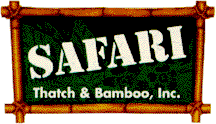
|

|

|
Safari Thatch and BambooWynand OdendaalPO Box 91286 Austin, TX 78709 (512) 448-2000 (512) 448-2319 fax |
CONSIDERATIONS:
Most U.S. homes are constructed with wood framing. Although wood is a renewable resource, the amount of wood required for construction purposes is taxing the regenerative capabilities of this resource, as well as depleting a critical component in ecological balance. Trees affect water quality, rainfall, and air quality, both in the immediate region and on a global scale.
Although the status of the wood resource is hotly debated, it is clear that expanding demand simply due to population growth has or will have an impact on its long term viability. The reduction of primary forest cover has spurred further debate on the management of the forests as balanced ecosystems. Some new management approaches are based upon holistic sustainable principles. The principles of sustainability which underpins the Green Builder Program favors forest management practices that retain natural forest ecosystems.
Some of the options associated with this approach are difficult to implement. There are very few "certified" sustainably managed wood sources and certifying groups are still in the process of determining universal guidelines for certification. The active certifying organizations, listed at the end of this section, have developed strong ecologically based criteria. Wood certified by the groups mentioned in this section meets the criteria of the Green Builder Program.
Wood from old growth forests is not identified in final products, making the option of avoiding it very difficult. Most of the old growth trees are in Redwood and Douglas Fir regions; however, wood of these species exists that is not from old growth areas.
Southern wood species such as Yellow Pine are harvested in Texas. Using a regional species can provide an economic benefit to the state and to our area. The growth/removal rate for Yellow Pine looks positive for the future; although increased demand could cause problems. The increased use of engineered wood from all species reduces waste and is beneficial. Additionally, using smaller dimensional wood (less than 2x10) allows smaller trees to be used which can be helpful in tree farming rotations (common to Yellow Pine).
| Commercial Status |
Implementation Issues |
||||||
|---|---|---|---|---|---|---|---|
| Southern Softwood | |||||||
| Large Dimension | |||||||
| Old Growth | |||||||
| Certified | |||||||
| Legend | |
|---|---|
| Satisfactory |
|
| Satisfactory in most conditions |
|
| Satisfactory in Limited Conditions |
|
| Unsatisfactory or Difficult |
|
"Certified" wood will become more available over time. Certification organizations should indicate an association with the Forest Stewardship Council (an international coalition promoting a common set of principles and guidelines used to evaluate certifying organizations).
RESOURCES
PROFESSIONAL ASSISTANCE
Precision Woodworks
507 E. Jackson St.
Burnet, TX 78611
(512) 756-6950
Recycled wood supplier
What It's Worth
P.O.Box 162135
Austin, TX 78716
(512) 328-8837
Recycled Wood Supplier
Delta Lumber & Millwork
4701 E. 5th St.
Austin, TX 78702
(512) 385-8522
Recycled Wood Suppliers
Ken Richter Dismantling
2203 Lillie Lane
Taylor, TX 76574
(512) 924-3108
Recycled Wood Supplier
Pam Gaylor Dismantling
Rt.1, Box 750-H
Elgin, TX 78621
(512) 332-0819
Recycled Wood Supplier
EcoTimber International
1020 Heinz Ave.
Berkeley, CA 94103
(510) 549-3000
ecotimber@ecotimber.com
Sustainable Wood Suppliers
Kane Hardwood
Route 6, P.O.Box 807
Kane, PA 16735
(814) 837-6941
Sustainable Wood Suppliers
Keweenaw Land Association
1801 E. Cloverland Dr.
E. US Hwy 2, P.O.Box 188
Ironwood, MI 49938
(906) 932-3410
Sustainable Wood Suppliers
Seven Islands Land Management Co.
112 Broadway
P.O. Box 1168
Bangor, ME 04402-1168
(207) 947-0541
Sustainable wood suppliers
Collins Pine Co.
1618 S.W. 1st Ave., Suite 300
Portland, OR 97201
(800) 329-1219
Sustainable Wood Suppliers
Menominee Tribal Enterprises
P. O. Box 10
Neopit, WI 54135
(715) 756-2311
or
P.O. Box 670
Keshena, WI 54135-0670
(715) 799-3896
Sustainable Wood Suppliers
Big Creek Lumber
3564 Highway 1
Davenport, CA 95017
(408) 423-4156
Sustainable Wood Suppliers, second growth redwood and douglas fir
Rogue Institute for Ecology and Economy
P. O. Box 3213
Ashland, OR 97520
(503) 488-2469
http://id.mind.net/~roguinst/
certifying organization
Scientific Certification Systems
Forest Conservation Program
1611 Telegraph Ave., Ste. 1111
Oakland, CA 94612-2113
(510) 832-1415
www.freemancorp.com/fcp.html
certifying organization
Forest Stewardship Council
R.D. #1, Box 182
Waterbury, VT 05676
(802) 244-6257
FSCUS@together.net
certifier's certifying organization
Certified Forest Products Council
14780 SW Osprey Drive, #285
Beaverton, OR 97007
(503) 590-6600
cfpc@ix.netcom.com
http://www.certifiedwood.org
certifying organization
Southern Forest Products Association
Treated and Residential Markets Manager
P. O. Box 641700
Kenner, LA 70064-1700
(504) 443-4464
ISF Smartwood Certification
46 Humboldt Street,
Willits, California 95490
Phone: 707-247-1101
Fax: 707-247-3555
e-mail: isf@pacific.net
certifying organization
Certification Monitoring Network
http://www.cmnet.org
monitor certification uses in advertising
The Wood Users Guide
Rainforest Action Network
221 Pine St., Suite 500
San Francisco, CA 94104
(415) 398-4404
http://www.ran.org
guide to tropical hardwoods & alternatives
The Forest Trust and Good Wood Inc.
P.O.Box 519
Santa Fe, NM 87504-0519
(505) 983-0798, foresttrust@igc.apc.org
community forest educational organization, also a sustainable wood broker
The Southern Cypress Manufacturers Assn.
400 Penn Center Blvd., Suite 530
Pittsburgh, PA 15235
(412) 829-0770
return to Table of Contents
Sustainable Building Sourcebook web version copyright Sustainable Sources 1994-1999.